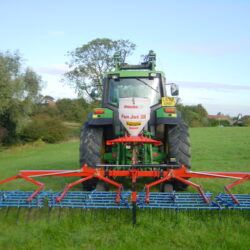It is estimated that around 20% of losses in livestock production worldwide can be attributed to animal diseases. In Southern Africa, tick-borne diseases remain some of the key illnesses responsible for preventable economic losses in livestock production. Global warming is also inevitably making it possible for implicated vectors to survive in geographies where they did not traditionally occur before, or at least not in numbers high enough to create a disease concern.
ANAPLASMOSIS (GALL-SICKNESS OR GALSIEKTE)
WHAT IS IT?
Anaplasmosis is a severe disease of mostly cattle, even though the infection has also been described in sheep, goats and other wild species. This disease, transmitted by infected ticks, exhibits the most prominent clinical signs in cattle and is therefore commonly assumed to be exclusive to cattle.
Anaplasmosis is often wrongly used to describe certain disease conditions like ordinary constipation (dry anaplasmosis), ingestion of certain toxic plants, or any condition which on post-mortem carcasses present with a swollen gall bladder.
The parasites found in ticks that cause the disease are Anaplasma marginale and Anaplas ma centrale. They infect ticks when they bite and feed on infected animals or previously recovered animals that have become carriers. A. marginale often leads to severe disease and deaths.
A. centrale is less harmful and used in vaccine production to help protect animals against losses associated with A. marginale.
The disease is transmitted predominantly by blue ticks, even though transmission by other tick species and mechanical transmission by blood-sucking insects has been reported. Tools and equipment that make contact with infected biological fluids (mostly blood) during veterinary procedures have also been implicated in disease transmission.
Once in the herd, the disease can be transmitted to other cattle when one needle is used to inject several animals. Other veterinary procedures such as dehorning, branding, castration, ear-notching and tattooing can also place animals at risk if the necessary hygiene precautions are not taken. The disease can also be transmitted to calves from their pregnant mothers.
DISTRIBUTION
The disease is much more widespread than other tickborne diseases, driven mostly by the presence and survival of host ticks. In South Africa the disease has been reported in all nine provinces, but to a lesser extent in drier parts of the country that receive very low rainfall.
HOW CAN THE DISEASE BE RECOGNISED?
In some cases, the disease may remain undiagnosed but may manifest through fever (high body temperature), progressive anaemia and icterus (seen through yellowish discolouration of mucous membranes of, for example, the eyes, gums and vulvae). All ages of cattle are susceptible to infection but the severity of the disease seems to increase with age, especially after two years of age, while calves under six months may generally be temporarily resistant to the disease.
In the acute phase of the disease, owners may notice a rapid decline in milk production, rapid breathing, excessive salivation, nervous signs, loss of appetite, weight loss, abortions and lethargy. Infected animals are known to exhibit signs of constipation, often witnessed as very dry, bile-stained (and even bloody) dung. Severely affected animals may likely die if not treated correctly on time.
TREATMENT
Ideally the diagnosis must first be confirmed by someone familiar with the disease. This can be based on recognised symptoms and ideally a blood smear microscopically examined for the presence of the parasites.
Oxytetracycline antibiotics are still considered a highly effective treatment for anaplasmosis, especially when administered correctly and early enough in the course of the disease. Imidocarb can also be used.
Infected animals should be separated from the rest of the herd and given good nursing care, over and above medications. Where possible, sick animals shouldn’t be exposed to unnecessary stress.
Other interventions that may aid with the sick animals’ recovery include:
Avoiding transportation of sick animals over long distances.
Protection from unfavourable weather.
Provision of sufficient good quality food and clean, fresh water.
Handling facilities that allow safe restraint of the animals.
A mixture of sugar and vinegar or any other digestive aid intervention given orally to improve rumen function.
Injection of appetite stimulants.
Guarding against and attention to dehydration as much as possible.
PREVENTION AND CONTROL
A blood vaccine is available from Onderstepoort Biological Products (OBP) as a first line of defence against the disease, especially before the rainy season starts. The disease starts to manifest mostly during the warm summer and autumn months when tick populations are very high. It is best to vaccinate calves aged three to nine months of age, especially in case they may not have been naturally immunised through bites from presumably-infected ticks at an earlier age by infected ticks.
Judicious tick control is advocated as part of the control of anaplasmosis. This refers to dipping so as to prevent ticks from becoming a nuisance to animals while ensuring that the animals are not too clean of ticks. One needs to allow some degree of tick infestation to allow natural infection and immunity development, in conjunction with the use of vaccines.
ECONOMIC IMPLICATIONS
The economic implications of diseases such as anaplasmosis are never adequately recorded. These stretch beyond just the loss of an animal. Time lost during the care of a sick animal, lost productivity (in the case of reduced milk production up to abortions), the cost of medications (antibiotics and other supportive therapies) and irreplaceable genetics are just a few of the disease’s economic implications. The impact becomes a lot more pronounced in poor rural households that rely heavily on livestock production for survival.
GENERAL RECOMMENDATIONS
Farmers are encouraged to own a thermometer or two. It is a vital tool in your toolkit as most infections start with an abnormal (high) temperature before other signs start showing. If implemented early enough, this increases the chances of successful treatment. A digital rectal thermometer is preferred as it is much easier to use and read.
Please speak to your local veterinarian or animal health technician regarding customised vaccination programmes that can help make a difference in your operation. Please feel free to contact us on sello.maboe@obpvaccines.co.za or 012 522 1500 / 068 531 4488.




